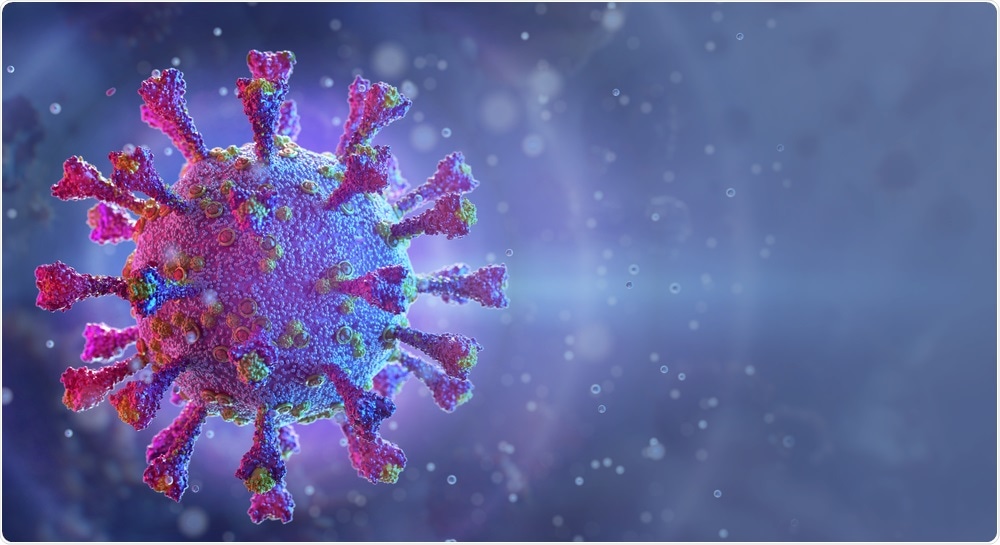Analysis of resting heart rate, activity, and sleep patterns, show infected individuals experienced delayed recovery and persistent negative impacts following COVID-19 infection.

SARS-CoV-2. Image Credit: Corona Borealis Studio/Shutterstock.com
Adapting health assessments with modern technology
With the ongoing global COVID-19 pandemic, researchers have focused on the symptomatic changes that patients experience over time. Of particular concern are the lasting consequences of the infection, which have been recognized to impact physiological and behavioral responses.
A new study led by Dr. Jennifer M. Radin and colleagues from the Scripps Research Translational Institute, San Diego, California, has demonstrated that the negative effects of COVID-19 infection can last up to 3 months.
The study is the first to examine temporal changes in health-related effects using wearable sensor data derived from the DETECT (Digital Engagement and Tracking for Early Control and Treatment) application. This app collects data from wearable devices of individuals across the USA to better understand individual changes associated with viral illness, including COVID-19.
Data was collected between March 25, 2020, to January 24, 2021, with a total of 37,146 participants enrolled. Of the total number of patients, the analysis then focused on 875 individuals that reported symptoms and had swab testing for COVID-19 and were found to be either positive (234 individuals) or negative (641 individuals).
To understand the long-term effects of infection, data was collected daily on the heart rate (resting heart rate), sleep (duration), and overall activity (step count). The analysis included both women and men between 18 and 76 years of age, providing a representative and comprehensive overlook of the persistent effects of infection.
Lasting negative impacts following COVID-19 infection but with interindividual variability
From the study population engaged, researchers found that individuals infected by COVID-19 took longer to return to their resting heart rate, sleep, and activity baselines compared to individuals that had symptoms but were COVID-19 negative.
This effect lasted 2 to 3 months, with the impacts on resting heart rate being the most persistent relative to other response variables considered.
The patterns of response were consistent among both men and women across all ages, as patients that had tested positive for COVID-19 showed higher resting heart rates than ones that tested negative.
Although data was collected only once during the early phase of acute infection, individuals that tested COVID-19 positive had a higher severity and frequency of symptoms compared to ones that tested negative. This pattern requires further examination and could be considered in future studies as the present work only tested individuals a single time in the acute infection phase.
Additionally, despite the large initial sample size, the final amount of usable data was limited, as the number of individuals used to compare specific symptoms sometimes numbered less than 10. By gathering more data over a longer period with multiple measurement periods, this limitation could be addressed, expanding the findings of this study further.
Nonetheless, this study is the first to provide longer-term findings on the physiological and behavioral impacts of COVID-19 infection. Importantly, the use of data collected from wearable sensors could provide a new method for clinical trials to gather data from a larger sample population. This strategy also allows remote data collection that would avoid gathering potentially infected individuals into specific areas.
Future studies could build upon the findings of the present study to further explore the consequences of infection, and consider additional factors such as the effects of SARS-CoV-2 variants, the benefits of antiviral drugs or vaccinations, as well as demographic variations.
- JAMA Network Open. 2021;4(7):e2115959. doi:10.1001/jamanetworkopen.2021.15959
Posted in: Medical Science News | Medical Research News | Disease/Infection News | Healthcare News
Tags: Coronavirus Disease COVID-19, Drugs, Frequency, Heart, Heart Rate, Pandemic, Research, SARS, SARS-CoV-2, Sleep

Written by
James Ducker
James completed his bachelor in Science studying Zoology at the University of Manchester, with his undergraduate work culminating in the study of the physiological impacts of ocean warming and hypoxia on catsharks. He then pursued a Masters in Research (MRes) in Marine Biology at the University of Plymouth focusing on the urbanization of coastlines and its consequences for biodiversity.
Source: Read Full Article